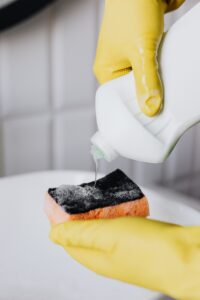Latex Allergy
In recent years, the incidence of occupational asthma in healthcare workers has increased. One of the leading causes of this increase is worker exposure to latex. If you are allergic to latex, you will see symptoms after contact with latex products. Latex allergy symptoms can range from mild to severe.

People who are extremely sensitive to latex can develop an anaphylaxis reaction immediately after touching latex. Anaphylaxis reaction symptoms include: hives or swelling, difficulty breathing, wheezing drop in blood pressure, dizziness, confusion, loss of consciousness. Anaphylaxis reactions can be deadly so if you think you are experiencing one seek medical care immediately.
Health care workers are at a greater risk of developing latex allergy. People who undergo multiple surgeries and medical procedures are also at a greater risk. For more information on latex allergy, symptoms, prevention, and people at a greater risk of latex allergy, visit Mayo Clinic’s page on latex allergy. The CDC also has information on latex allergy.
What is Latex?
Latex products are manufactured from a milky fluid derived from the rubber tree, Hevea brasiliensis. During the processing and manufacturing of commercial latex, several chemicals are added to this fluid. Specific proteins in latex can cause a wide range of symptoms ranging from mild to severe allergic reactions. Unfortunately, no reliable and consistent method exists to measure allergy-causing proteins (antigens) and their concentration.
How are people exposed to Latex?
One of the leading causes of latex exposure happened in the healthcare setting because of latex gloves’ frequent use. Other locations include latex are housekeeping, hairdressers, and workers in industries that manufacture latex products. However, latex is also part of many products.
The following are examples of products that may contain latex:
- Emergency Equipment: Blood pressure cuffs, Stethoscopes, Disposable gloves, Oral and nasal airways, Endotracheal tubes, Tourniquets, Intravenous tubing, Syringes, Electrode pads.
- Personal Protective Equipment: Gloves, Surgical masks, Goggles, Respirators, Rubber aprons
- Office Supplies: Rubber bands, Erasers
- Hospital Supplies: Anesthesia masks, Catheters, Wound drains, Injection ports, Rubber tops of multidose vials and bottles, Dental dams
- Household Objects: Automobile tires, Motorcycle and bicycle handgrips, Carpeting, Swimming goggles, Racquet handles, Shoe soles, Expandable fabrics (waistbands), Dishwashing gloves, Hot water bottles, Condoms, Diaphragms, Balloons, Pacifiers, Baby bottle nipples.
How can I protect myself from Latex Allergy?
- Do not use latex gloves for activities whenever possible, especially when in contact with non-infectious material
- Choose powder-free latex gloves instead of powered (they decrease protein content, thus may reduce reactions to chemical additives in latex
- Protective practicing includes: avoid oil-based hand creams or lotions because they cause glove deterioration
- Frequently wash your hands with soap and water and dry
- Become familiar with employer-based education and request provision of latex-free gloves
- Best protection is to avoid contact with latex-containing products via contact and inhalation routes
